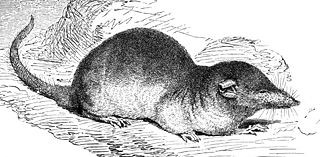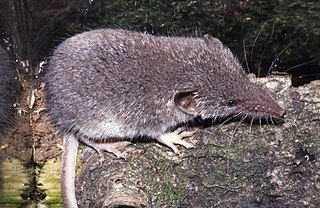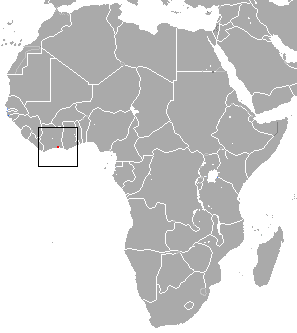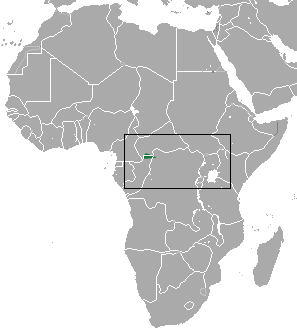
The white-toothed shrews or Crocidurinae are one of three subfamilies of the shrew family Soricidae.

The lesser white-toothed shrew is a small species of shrew with a widespread distribution in Africa, Asia and Europe. Its preferred habitat is scrub and gardens and it feeds on insects, arachnids, worms, gastropods, newts and small rodents, though its diet usually varies according to the biotope where it lives. The closely related Asian lesser white-toothed shrew was once included in this species, but is now considered to be a separate species.

The Harenna shrew is a white-toothed shrew found only in one location in the Bale Mountains in southern Ethiopia. It occurs within an area of less than ten square kilometres, and is listed as a critically endangered species, due to habitat loss and a restricted range.

The São Tomé shrew is a white-toothed shrew about 3.0 in (7.6 cm) long found only on São Tomé Island, São Tomé and Príncipe. It is listed as a critically endangered species due to habitat loss and a restricted range. It was discovered in 1886. The population continues to decrease, making these animals rare. It is found only on São Tomé Island, a small island that is actually a shield volcano that rises out of the Atlantic Ocean.

Wimmer's shrew is a white-toothed shrew found only in Côte d'Ivoire. It is listed as a critically endangered species due to habitat loss and a restricted range.

The genus Crocidura is one of nine genera of the shrew subfamily Crocidurinae. Members of the genus are commonly called white-toothed shrews or musk shrews, although both also apply to all of the species in the subfamily. With over 180 species, Crocidura contains the most species of any mammal genus. The name Crocidura means "woolly tail", because the tail of Crocidura species are covered in short hairs interspersed with longer ones.

The Ussuri white-toothed shrew is a species of musk shrew found on the mainland Northeast Asia. It is common and widespread, and is one of the largest shrews found in the region, with adult weight of 14–25 g (0.49–0.88 oz). It should not be confused with the related Ussuri shrew.

Bates's shrew is a species of mammal in the family Soricidae. It is found in Cameroon, Republic of the Congo, Equatorial Guinea, and Gabon. Its natural habitat is subtropical or tropical moist lowland forests. This large black shrew was first described by the British zoologist Guy Dollman in 1915, the type locality being the vicinity of the Como River in Gabon. The exact definition of this species is unclear; it is often included in Fraser's musk shrew, or reported as Wimmer's shrew. Its karyotype is 2n=50, FN-76, which is identical to the Nigerian shrew, and the species complex is in need of a thorough revision.

The African dusky shrew or African foggy shrew is a species of shrew. It is native to the Democratic Republic of the Congo, where it lives in forests.

The Sulawesi shrew is a species of mammal in the family Soricidae. It is endemic to the central and northern provinces of Sulawesi in Indonesia. It is a fairly common species and the International Union for Conservation of Nature has assessed its conservation status as being of "least concern".

The Ugandan musk shrew is a species of mammal in the family Soricidae. It is found in Uganda, the Democratic Republic of Congo and the Central African Republic. Its range, population size and habits are poorly known.

The black-footed shrew is a species of mammal in the family Soricidae. It is endemic to northern and central Sulawesi, Indonesia where it lives on the floor of the tropical forests. The International Union for Conservation of Nature has assessed its conservation status as being of "least concern".

The pale gray shrew is a species of mammal in the family Soricidae. It is endemic to Pakistan and is distributed in the Shigar valley and the western edge of Deosai.

The Egyptian pygmy shrew or sacred shrew is a species of mammal in the family Soricidae. It is endemic to Egypt. Its natural habitat is arable land. It is threatened by habitat loss, partially caused by the construction of the Aswan Dam. They are 48–62 mm (1.9–2.4 in) in length and weigh 7 g (0.25 oz), making them one of the smallest shrews in Egypt.

The Sulawesi white-handed shrew or Temboan shrew is a species of mammal in the family Soricidae. It is endemic to the island of Sulawesi in Indonesia. It is a fairly common species and the population seems stable so the International Union for Conservation of Nature has assessed its conservation status as being of "least concern".

The Ugandan lowland shrew or Moon shrew, is a species of mammal in the family Soricidae. It is found in Kenya and Uganda. Its natural habitats are subtropical or tropical swamps and montane forests.

The Sicilian shrew is a species of mammal in the family Soricidae. It is found in Sicily (Italy) and Gozo (Malta). Its natural habitat is temperate shrubland.

The Timor shrew or thin shrew is a species of mammal in the family Soricidae. It is endemic to Timor.

The Kinabalu shrew is a species in the family Soricidae. It is endemic to the mountain Mount Kinabalu on Borneo, and its sister peak, Mount Tambuyukon.

The Indochinese shrew is a species of white-toothed shrew native to Southeast Asia. It was first identified in 1922 by Herbert C. Robinson and C. Boden Kloss. The species is often taxonomized as a subspecies Horsfield's shrew, but bears a different range, occurring in Myanmar, Vietnam, and the Yunnan province of China.




















